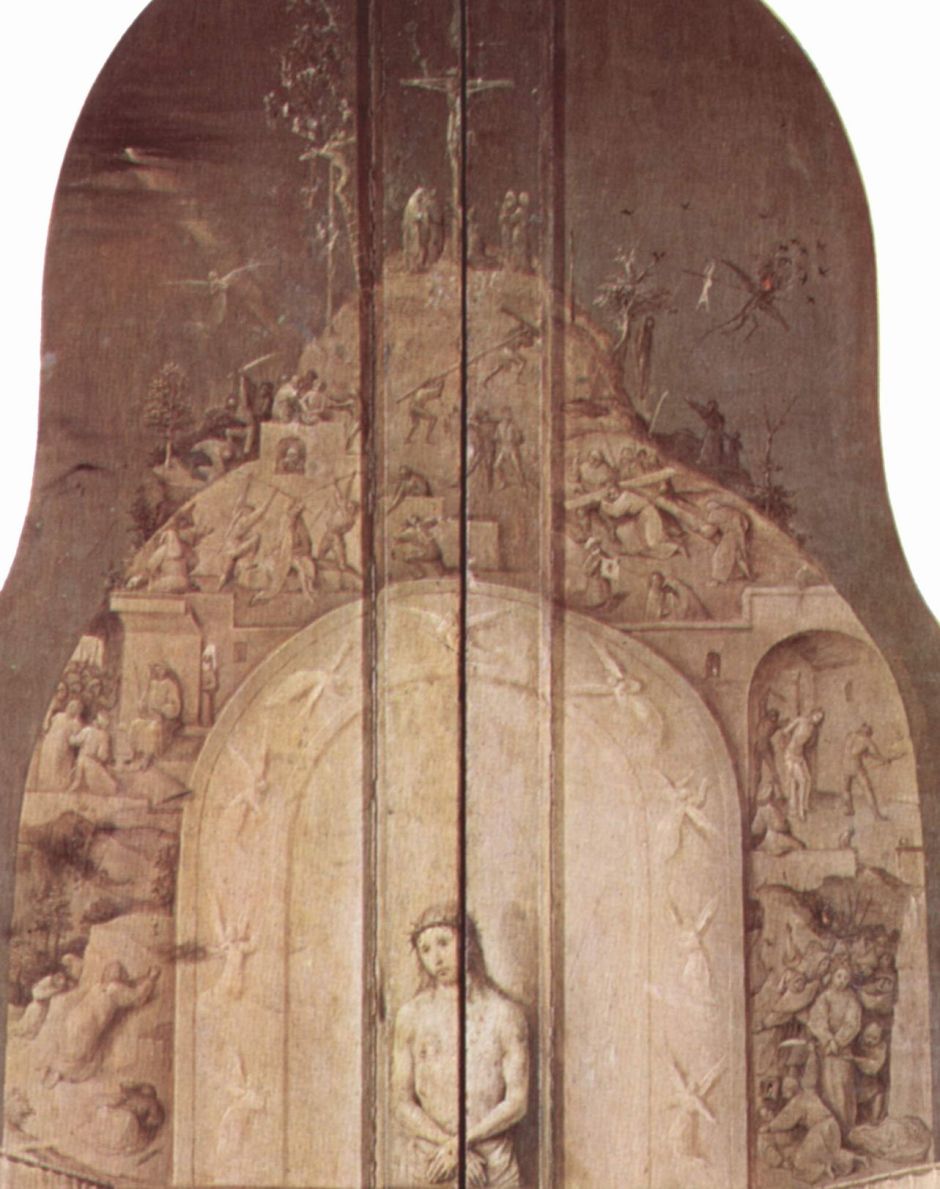In the first of these two articles looking at complete accounts of the Gospel narratives of the Passion, I showed two early examples of how they were told in individual cells or paintings within a whole, how Hans Memling merged them into a single continuous multiplex story, and ended with Bosch’s ingenious circular approach more directly derived from mediaeval paintings of the Wheel of Fortune.
That isn’t the only example from Bosch’s surviving work, though.

The exterior of Bosch’s Adoration of the Magi is another brown grisaille, this time showing the Mass of Saint Gregory. Above and behind its altar is the figure of the resurrected Christ, still showing the marks of crucifixion on his side and hands, and wearing his crown of thorns.
Around Christ is a border of angels, and around those an arched area which contains seven scenes of the Passion. These are read from the bottom left (Christ praying in Gethsemane), bottom right (the arrest), through the mid-left and mid-right, to the crucifixion at the top. Outside those narrative scenes are some more unconventional elements, including a winged devil flying off with Judas’s pale body impaled on a long lance.

Other painters continued with the familiar technique using multiple cells.

This anonymous Triptych with Scenes from the Life of Christ painted in Bruges between about 1500-05 has been carefully laid out to make the most of its three panels. At the left are the Anunciation and Nativity from the opening of the Gospels, the central panel covers the Passion, and the right panel the Resurrection. Unfortunately the order of scenes in the central panel doesn’t follow a continuous sequence. At first it might appear to show two separate crucifixions, but the garden of Gethsemane appears in the third row down, immediately below the (first) crucifixion. These scenes thus appear more iconic than narrative in their intent.
One of the most famous of these complete accounts of the Passion is Gaudenzio Ferrari’s fresco in the Church of Santa Maria delle Grazie.

Ferrari’s Stories of The Life and Passion of Christ, which he painted in 1513, uses twenty frames to cover the life of Christ. At its centre is a dominating frame with four times the area of the others, showing the Crucifixion. The frames are naturally (for the European) read from left to right, along the rows from top to bottom, although the crucifixion is part of the bottom row. This layout is commonly used for graphic novels.
At the top left is the Annunciation, and the sequence ends with the Ascension at the bottom right.

Frans Francken the Younger’s Crucifixion of Christ, with Scenes from the Life of Jesus, presumed to have been painted during the first half of the seventeenth century, puts the crucifixion scene at the centre of a rectangle, around which there are twelve scenes from the life painted in either normal or brown grisaille. Unfortunately those peripheral scenes are difficult to differentiate from one another, thus to identify, but they appear to be read in a clockwise direction from the upper right, rather than linearly.
By the eighteenth century, these narrative techniques had fallen into disfavour, and wouldn’t be rediscovered until the Swiss artist Rodolphe Töpffer created sequentially illustrated stories in the early nineteenth century. They did appear occasionally in more traditional devotional art.

The painting of The Virgin Mary (1700s) in the Serbian Church of Szentendre, Hungary, uses a rectangular format with the Virgin and Child at its centre. Arranged around that are smaller frames, each showing an event in the life of Jesus. These appear to be read from the upper left in an anticlockwise sense, ending at the upper right with the Resurrection, although only the ten frames on either side of the central image form the narrative sequence.
My final painting is another unique work which progresses from the Passion of Christ to the fates of his Apostles.

Fedor Nikitin Rozhnov’s The Passion of The Apostles (1699) arranges circular images of ‘popular’ scenes of the martyrdoms of the twelve apostles, around a central circular image of Christ’s crucifixion. The Wheel of Fortune is turning full circle.
So it did in the late nineteenth century, when the same narrative techniques were used to tell wholly secular stories. Oddly, fine art painters seem never to have returned to these forms of visual narrative.

